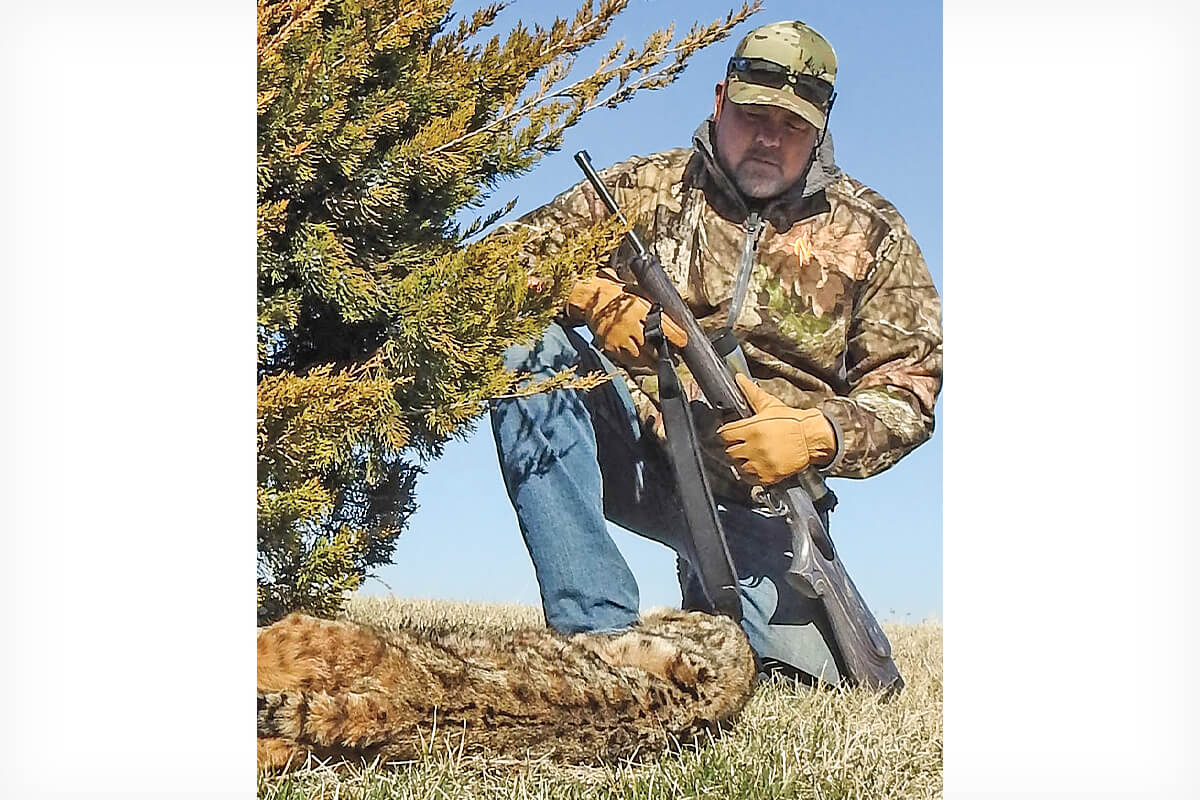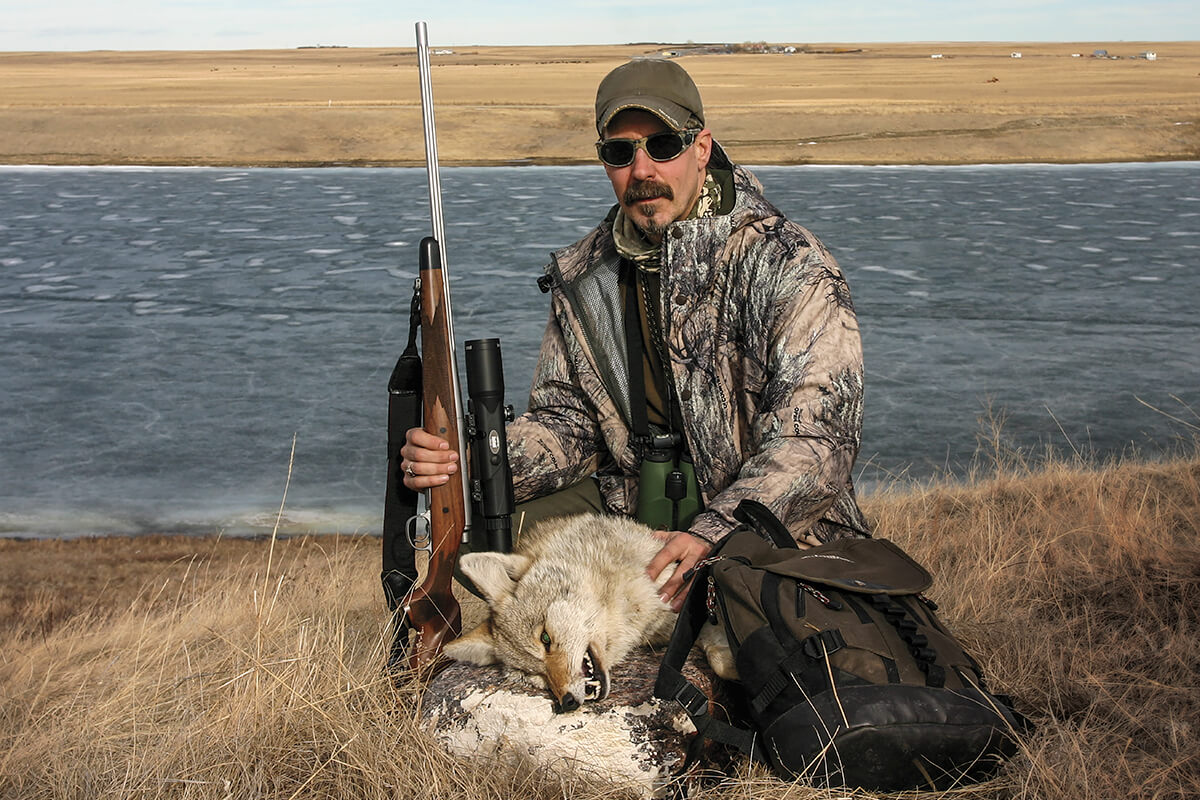
Does the .17 caliber cartridge have enough put-down power for predators? (Petersen’s Hunting Photo)
My introduction to the diminutive .17 caliber came via a mid-winter coyote caper in southwestern Alberta. I hunted mule deer there the previous year with a good buddy, Andre van Hilten, owner of Willow Creek Outfitters. The predator hunter in me couldn’t help but notice the abundance of coyotes as we picked apart the landscape with our optics in search of antlers. So it was no surprise the next January I was following Andre down a sharp ridgeline where we set up overlooking a spiderweb of brushy draws that converged at a frozen stock pond.
It was that magical crepuscular time of the morning all coyote hunters cherish. The breeze was cool and wispy as the sun peeked over the horizon. Andre laid into the rabbit distress call with the guttural growl of a chain-smoking blues singer, causing the hairs on the back of my neck to stand and applaud. I watched the hills come to life as coyotes began crawling out of the woodwork. Nine in all! Most were milling around several hundred yards out, finishing up the night shift and paying us very little attention. Then I spotted two coming hard, one down a fence line, the other circling the far end of the stock pond. I’d like to say that we cleaned house, but circumstances conspired to produce a big fat zero. Don’t ask, and I won’t tell. No worries, though. There was no shortage of coyotes and we’d get a chance at redemption in this predator-rich environment.
That reckoning came in the form of several rugged-out coyotes over the next few days of hunting, firmly planted by the formidable .17 Remington Fireball and its petite 20-grain AccuTip-V projectile. This hunt occurred a few years back when Remington first introduced the cartridge—a necked-down version of its .221 Fireball—and paired it with the also petite Model Seven rifle. I was one of a handful of early test subjects asked to measure its mettle. While I was somewhat skeptical of using such a small bullet on such large northern coyotes, that concern proved to be unfounded. A look at my notes from that hunt demonstrates the efficiency of this formidable little cartridge.
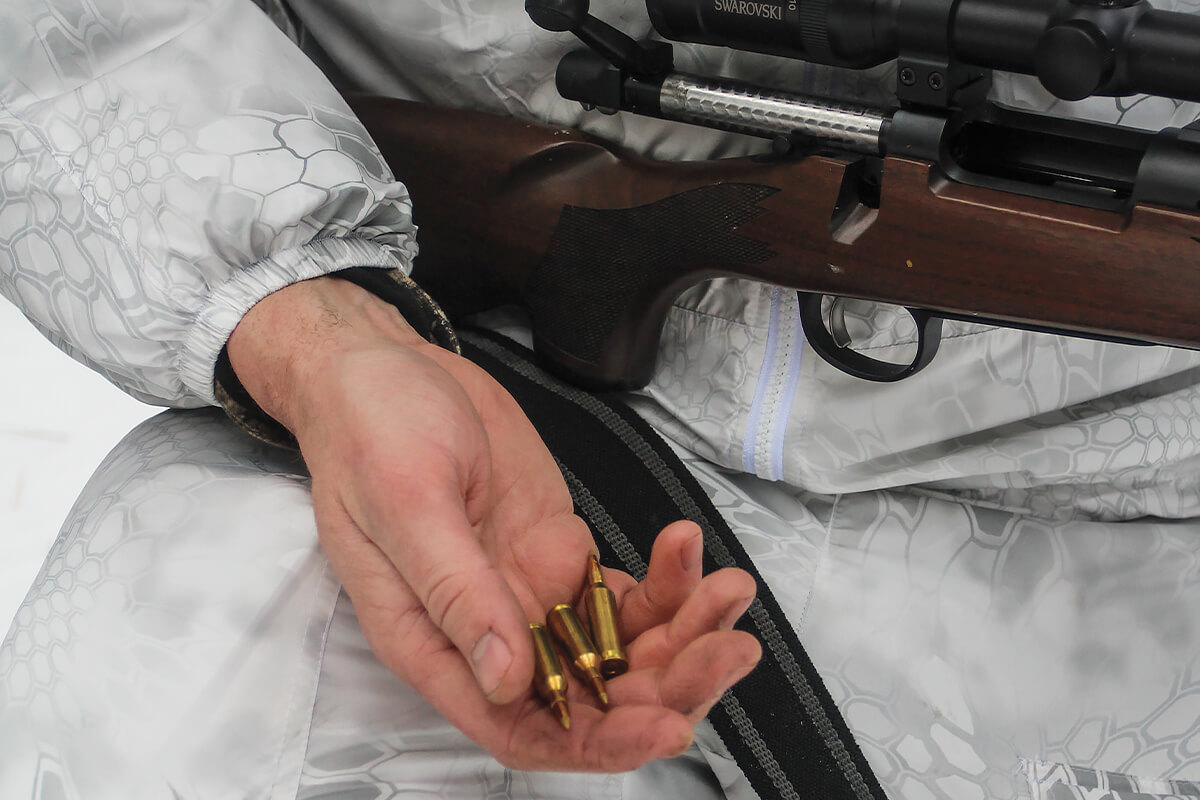
On that Alberta hunt we had no unrecovered coyotes. The longest shot—193 yards—to a broadside coyote dropped it in its tracks with no exit wound. A shot at 170 yards netted a similar result: instant death with no exit wound. A shot to the head at 171 yards dropped another coyote with an exit wound that caused only minimal damage. Only one coyote showed considerable fur damage: a frontal shot at 94 yards that encountered bone and exited out the shoulder.
Another group of hunters in Wyoming experienced similar results with kills ranging from 60 to 250 yards with no unrecovered coyotes. Only one hit coyote went a considerable distance and required a finishing shot. The dog shot at 250 yards was hit to the rear of the lungs, and the tough canine traveled 200 yards before succumbing.
Currently, there are three major .17-caliber centerfire cartridge offerings: .17 Remington, .17 Remington Fireball, and .17 Hornet. Each comes factory loaded with a decent selection of special-purpose varmint and predator bullets. I’d be remiss in not mentioning a lengthy list of wildcats, such as the .17 Ackley Bee, .17 Ackley Hornet, .17 MACH IV, .17 Javelina, and others.
So let’s set the stage by first looking at the three factory offerings in .17 caliber:
17 Remington
The first modern-day factory-loaded .17 varmint cartridge was the .17 Remington, introduced in 1971. It’s the hottest of the bunch (excluding the wildcats), and its angry little 20-grain Remington Premier AccuTip-V bullet leaves the barrel at 4,250 fps. This cartridge is based on the .223 Remington case (with some dimensional changes) necked-down to accept 0.172-inch-diameter bullets. Like its parent case, the rim diameter is 0.378 inch, and the shoulder angle remains 23 degrees.
.17 Remington Fireball
Remington launched the .17 Fireball, a necked-down version of its .221 Fireball, in 2007. It pushes the 20-grain Remington Premier AccuTip-V bullet out the barrel at 4,000 fps, almost matching the .17 Remington. But it uses significantly less powder than the .17 Remington and therefore produces less heat and fouling, which can be an issue with the high volume varmint hunters shoot. The .17 Remington Fireball was Remington’s factory-produced answer to the popular .17 Mach IV wildcat, which it resembles.
.17 Hornet
The .17 Hornet was originally offered as a wildcat cartridge by P.O. Ackley during the early 1950s, as a necked-down version of the .22 Hornet. Shooting a 20-grain V-max bullet, it produces a muzzle velocity of 3,650 fps and generates 592 ft.-lbs. of energy. Its trajectory is similar to that of a .223 Remington shooting a 55-grain bullet but with the felt recoil of a .22 WMR. As with the Fireball, there is less fouling, barrel wear, powder, and pressure when compared to the .17 Remington.
The Pros
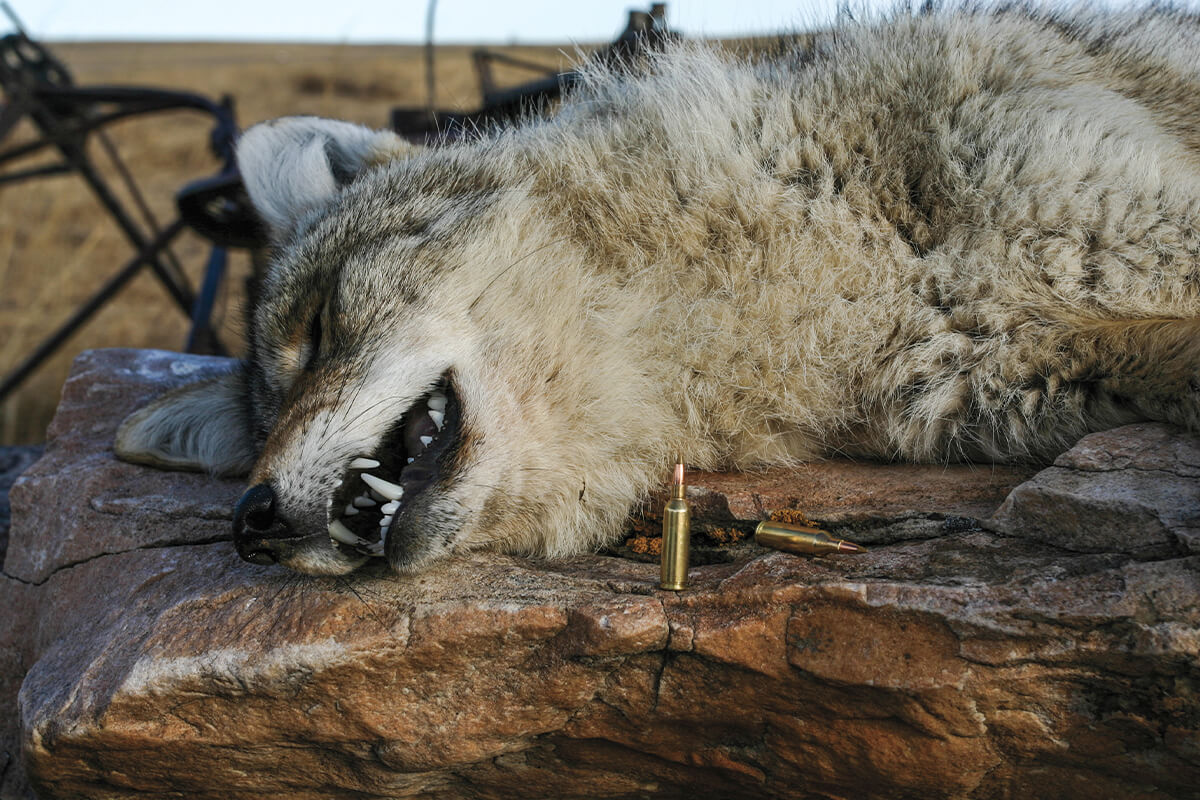
It doesn’t take more than a glance to recognize what these cartridges have in common and what makes them effective for terminating predators, even those as large as northern coyote.Velocity, which, of course, is one of two ways to produce foot-pounds of energy. The other way being bullet mass. With their itty-bitty, frangible bullets, speed is required to produce the energy and terminal performance needed for effective kills—especially when dealing with coyote-sized critters. But the tiny .17 pill does come with some limitations.
First, the good news. There are many good reasons why downsizing to these diminutive cartridges for fur hunting can make sense, especially when pursuing smallish critters such as foxes, bobcats, and raccoons at moderate ranges: reduced recoil, flat trajectory, minimal fur damage, small maneuverable rifles, etc. Of these reasons, the one that left the biggest impression when I hunted with the .17 Fireball in Alberta was its mild recoil, which meant never losing sight of the target. Even when using high-powered optics, I could actually see the bullet hit fur on the coyotes I killed and that means I could often determine where the animal was hit and make quick follow-up shots when necessary. That’s because the .17 Fireball cartridge uses 50 percent less powder than the popular .22-250 Remington and generates 86 percent less recoil.
Next on the list of attributes is flat trajectory. Using the .17 Remington as an example, its 20-grain AccuTip-V bullet leaves the barrel at a blistering 4,250 fps, giving it a trajectory similar to the consummate varmint-getter, the .22-250 Remington, which has a muzzle velocity of 3,800 fps with a 50-grain version of the same bullet. With a 250-yard zero, the .17 Remington drops 2.5 inches at 300 yards and 13.5 inches at 400 yards. Comparatively, the .22-250 Remington with the same 250-yard zero drops 2.7 at 300 yards and 12.2 inches at 400 yards.
The next two characteristics—accuracy and terminal performance—have a lot to do with the bullets typically loaded for these cartridges, such as the aforementioned Remington AccuTip-V, Hornady V-MAX, Nosler FBHP Varmageddon, and others. In varmint calibers, these bullets, albeit small, combine superb flight characteristics and match-grade accuracy with a design optimized for explosive on-game results. Ballistic-tip bullets are death to thin-skinned critters, such as foxes, bobcats, and coyotes. The AccuTip-V performed as expected on those Alberta coyotes: a small entrance hole, explosive expansion, and very few exits. Most of the coyotes were dead before they hit the ground.
Finally, for outback hunts, lightweight, maneuverable rifles are the flavor of the day—for example, Remington’s Model Seven, Ruger’s 77/17, and Savage’s Walking Varminter. The fact that recoil isn’t an issue with the .17s means shedding weight makes sense when covering lots of ground or rugged terrain in pursuit of predators.
The Cons
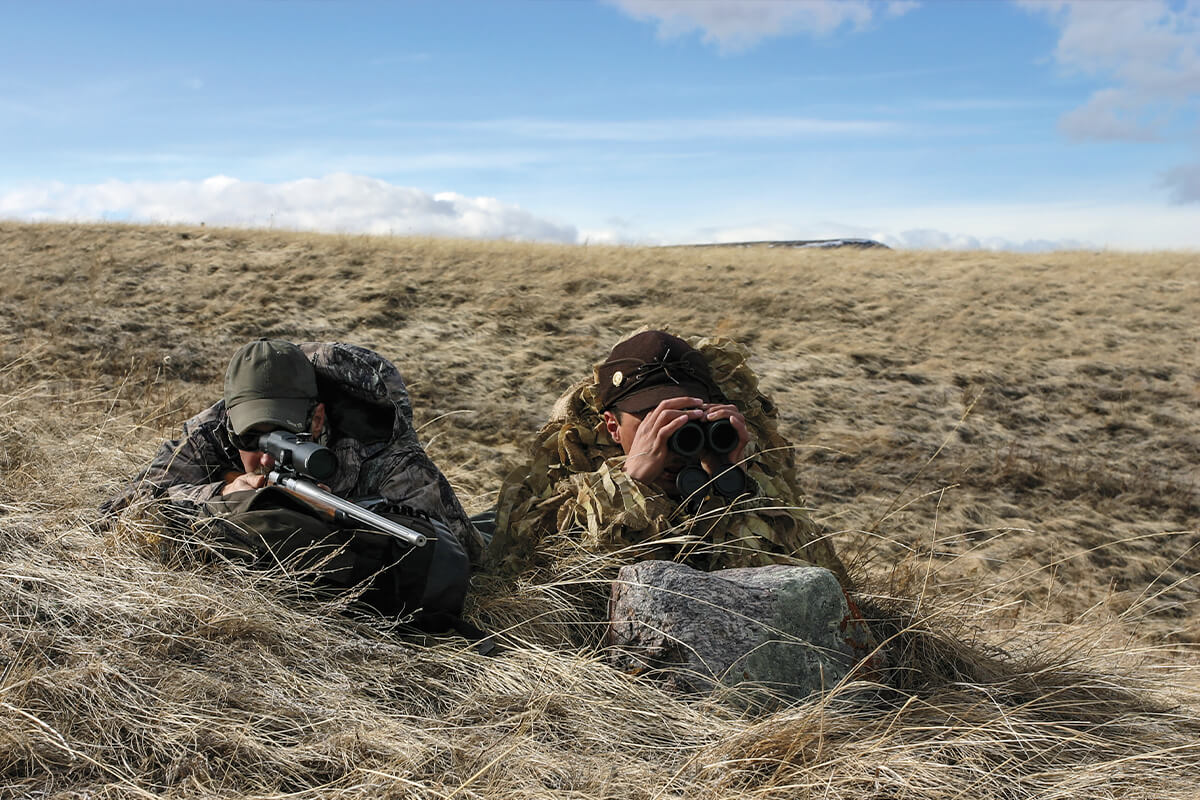
OK, now for the not-so-good news. There are times when these undersized cartridges might get a fur hunter in trouble, such as when hunting in windy conditions or when hunting larger predators or a mixed bag of predators. The trade-off is that the lighter bullets produce less energy at the muzzle and shed it much quicker than heavier bullets, making them less effective as the yardage to the target increases. The .22-250 Remington produces nearly twice the foot-pounds of energy at the barrel—1,603 vs. 802—as the .17 Remington and 536 vs. 192 ft.-lbs. at 400 yards. That’s why I consider the .17s to be moderate-range cartridges for fur hunting, effective to 200 yards or so but not so much beyond that.
And as mentioned, wind drift is an issue with these lighter bullets when compared to larger calibers and their heavier bullets. Consider a .22-250 Remington pushing a 55-grain ballistic-tip bullet in a 20-mph crosswind. Hunters can expect 7.3 inches of drift at 200 yards and 17.5 inches at 300 yards. Compare that to the .17 Hornet pushing a 20-grain ballistic-tip bullet: 11.4 inches of drift and 200 yards and 28 inches of drift at 300 yards. For that reason, I often opt for larger calibers and heavier bullets if I know I’m going to be experiencing blustery conditions while hunting.
One last thing. Small-bore rifles generally need to be cleaned more frequently to maintain their accuracy.
I’m not ready to retire my .22-250 Remington rifles from active coyote duty, and I still have reservations about the downrange energy and wind-bucking ability of the 17-caliber cartridges on coyote-sized critter past 200 yards. But for light duty on fox-sized critters and coyotes at moderate ranges, these feisty little cartridges hold a secure position in my battery of predator/varmint rifles.
